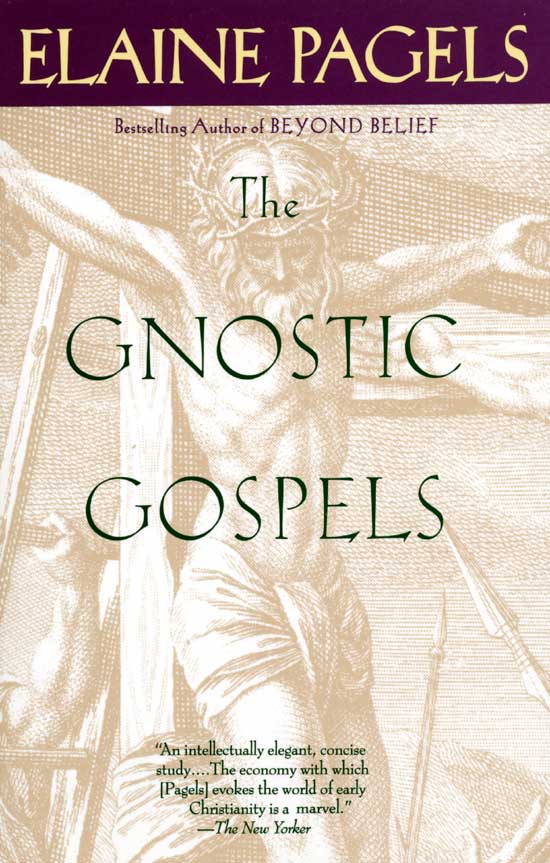The Gnostic Gospels
Tags: religion,
In 1945, an Egyptian peasant discovered a huge clay jar just beneath the soil near a cliff in Nag Hammadi, Egypt. Hoping to find treasure inside, he broke it open and, to his disappointment, found nothing but books.

Scholars and theologians had known for centuries of the early Christian Gnostic sects. Surviving letters and manuscripts of early church fathers railed against the beliefs and practices of these “heretics,” decried their “false” scriptures, and eventually succeeded in suppressing and destroying the writings that laid out their faith and described their practices.
For seventeen centuries, all that scholars knew about the Gnostics was what their enemies in the orthodox church had to say about them. Then, all at once, their writings resurfaced in this most unlikely find and the modern world got to see the Gnostic teachings firsthand.
The Gnostic Gospels examines the struggle in the first two centuries of Christianity between the orthodox church and these unorthodox mystics. The orthodox church centralized power, created a hierarchy similar to the ruling Roman empire, codified beliefs, and incorporated ritual into its worship. It was a social organization with a well-defined political structure.
The Gnostics, on the other hand, encouraged individuals to pursue their own understanding of God. There were no prescribed beliefs or practices. Individuals found God by seeking Him through intuition, meditation, questioning, desire and openness.
The orthodox church approved the books that became the New Testament, selecting those that supported the ideas of authority and hierarchy that the church embodied, and rejecting those that threatened or contradicted its power structure. The Gnostics, having no political structure and no need to select a body of scripture that would justify one, were much more open. The gospels they accepted contained ideas heretical to the church: that women were spiritually the equal to men and were fit to learn, preach, and teach; that God was accessible to all without the mediation of church or priest; that the resurrection could be interpreted metaphorically rather than literally; that the teachings of Jesus didn’t need to be justified by the Jewish prophets, the were strong enough on their own.
To the orthodox, the church was the hierarchy, the ritual mass and the profession of the creed. To the Gnostics, the church had no body. It existed wherever the spirit of faith existed.
Pagels' dive into the early history of the church, its internal rivalries and its persecution at the hands of the Romans is fascinating and disheartening. The Gnostics were ultimately doomed by their individualism and lack of political structure. How long can a herd of cats remain a herd? They were up against the persecution of the Romans and the hatred of the orthodox, who viewed their rejection of authority as an existential threat.
The orthodox church prevailed for two reasons. First, its administrative structure was modeled on the very effective structure of the Roman empire, and second, it provided a simple way in for all people of all cultures. Unlike the Gnostics, who provided no road map to or definition of a “proper” religious life, the orthodox church simply asked that you repeat the creed, attend the mass and obey the priest.
The disheartening part of this book lies in the description of the conflict between the church and Rome, and between the sects within the church itself. The Roman empire was in many ways similar to today’s totalitarian states, demanding cultlike devotion to the emperor and responding to dissent with crushing brutality.
Pagels notes that the emperor commanded the consuls of various regions to honor him with feast days, at their own expense. The feasts originally included gladiators and sports events. Over time, the consuls found that gladiators and sports teams had become too expensive, and that the illiterate crowds were just as amused at the sight of helpless Christians being torn to pieces. The best part about this was that Christians were free. You could stroll into town and round up dozens of them whenever you wanted.
The Romans had no idea what it actually meant to be Christian, and neither did the peasants who enjoyed watching them be torn apart. Neither group cared to understand them. Both agreed they were weird and other, and therefore it was find to kill them.
Fast forward two thousand years, and we’re still living this nightmare. The in-groups have changed and out-groups have changed, but their relationship hasn’t, especially in those authoritarian states where all power belongs to a single group.
The strife that Pagels describes within the church itself is also disheartening. Religion is inherently irrational, attempting to address the mystery of existence itself, which reason cannot comprehend. Disputes about the irrational quickly become nasty and violent, and the arguments of two thousand years ago, along with the grief they cause, persist to this day. They boil down to something like this:
Sect 1: The universe is vast beyond comprehension. It’s shot through with some inscrutable power that brings forth life everywhere, that raises the clay of the earth itself to walk and see and wonder. What it is and why it exists is entirely beyond the power of language to convey.
Sect 2: Indeed! It cannot even be named.
Sect 1: No, it cannot. Nevertheless, we call it Fred.
Sect 2: We call it Bill.
Sect 1: Blasphemer! Infidel!
Sect 2: Heretic!
Sect 1: How shall we resolve our differences?
Sect 2: Let’s kill each other.
Sect 1: Amen!